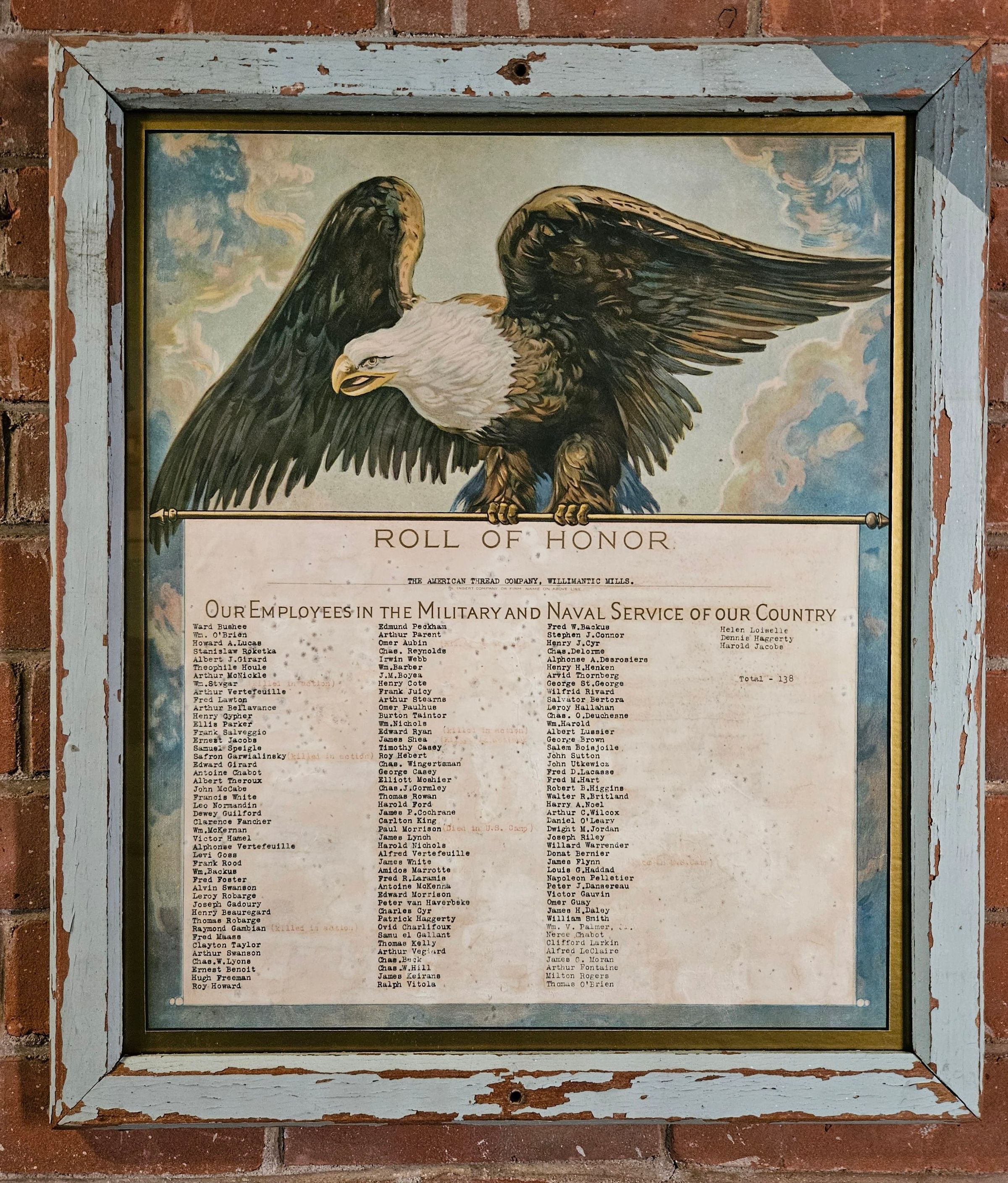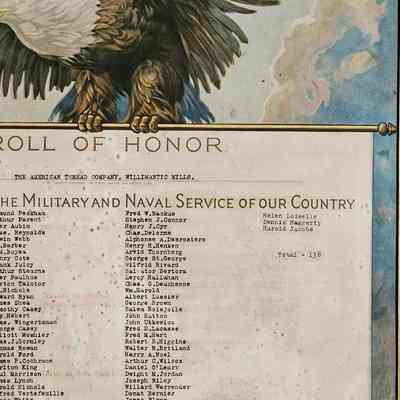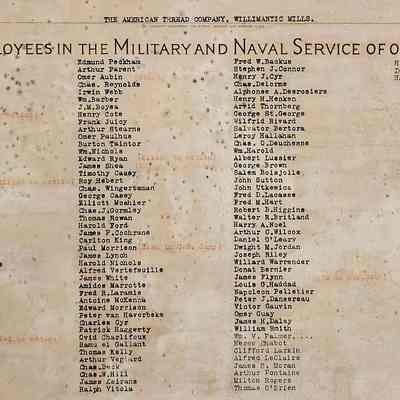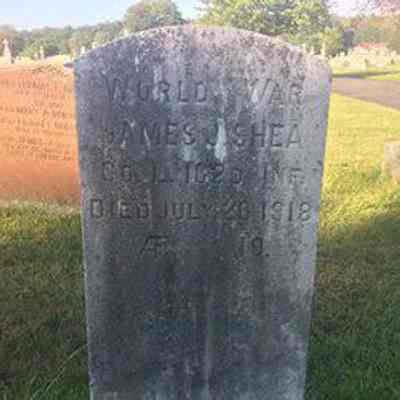Name/Title
Roll of Honor, American Thread CompanyEntry/Object ID
2024.50.01Scope and Content
Roll of Honor, the American Thread Company, Willimantic Mills. List of ATCO Willimantic Mills employees who served in the United States military in World War I. The names are typed with a typewriter on a pre-printed placard. The form features a color print of a bald eagle against a background of clouds and the words "Roll of Honor" and "Our Employees in the Military and Naval Service of our Country." The words "The American Thread Company, Willimantic Mills" are typed near the top. The names of 138 employees appear on the placard. The placard is in a wooden frame painted two shades of gray, colors used to paint interior walls in ATCO's Willimantic Mills plant. It is believed that the frame was supplied by ATCO, and that the placard was hung somewhere in the plant. The Mill Museum had the object reglazed in the 2010s. Although the placard does not expressly identify the names as World War I soldiers and sailors, the Museum has researched enough of the names to be sure that they were. Especially notable is James Shea, killed in action in France as part of the American Expeditionary Force; the American Legion Post in Willimantic, CT, is named for Shea.Context
For American soldiers, World War I was the third deadliest conflict in their country's history, following the Civil War and World War II. Although late to enter the war, he United States had a total of 4,272,500 soldiers, with 117,000 killed and 204,000 wounded -- fewer than those of Britain, France, Canada, Germany, Russia, Austria, or other countries in the war from the beginning, but significant nevertheless. Among them was James J. Shea. Shea was from Willimantic, CT, the son of Michael and Bridget Shea. He was killed in action at Chateau Thierry, France, on July 20, 1918. He was 19. He served in Co. L, 102nd Infantry.
Chateau Thierry was one of the first actions fought by the American Expeditionary Force under General "Black Jack" Pershing, a part of the Second Battle of the Marne. The Second Marne was a German offensive, intended to take advantage of the narrow window of opportunity between the end of the Eastern Front against Russia (which freed up thousands of German soldiers to fight on the Western Front in France) and the arrival, training, and deployment on the Western Front of the AEF to bolster the beleaguered French, British, and Canadian forces. The German offensive at Chateau Thierry -- only one part of the larger battle -- began in May, 1918. The Allied counter offensive occurred mostly in July. General Ludendorff, the head of the German military, planned to drive through the French lines along the Marne River, then swing north and trap the British and Canadians, who were not part of the battle. Pershing hitherto had refused to disperse US units among the French and British, insisting that the AEF remain together, under American commanders. But fear of German success at Second Marne caused him to relent and send troops to assist the French. These included the 102nd, which like most American troops had not yet seen action. Altogether, Chateau Thierry saw 1,908 Allied casualties and 5,328 German casualties, as the French and Americans first halted the German offensive and then counter-attacked. The Americans fought alongside French troops, including a large number of Africans from France's colonies. (The AEF was racially segregated, while the French army was not.) To catch the Germans off guard, the 102nd went “over the top” without the usual preparatory bombardment – a surprise attack. A "rolling barrage" dropped artillery just in front of the 102nd, providing some cover. After intense combat, the Germans were forced to withdraw, and the Americans and French captured a strategic high ground.
There is a memorial at Chateau Thierry designed by Paul Cret of Philadelphia, and another at the Bronx County Courthouse commissioned by the American Legion. In Willimantic, the local American Legion Post is named for James Shea, the 19-year-old Willimantic man who perished in France in the pivotal battle that helped halt Germany's last real chance to turn the tide of the war. There is a military gravestone for Shea at St. Joseph's Cemetery in Willimantic, CT, the city's Roman Catholic Cemetery.
Like Shea, Arthur Dion of Willimantic also served in Company L of the 102nd Infantry during the "World War." (In 1918, no one knew that a Second World War would follow.) Dion made it through Chateau Thierry, but died in on Dec. 26, 1918, shortly after the armistice that ended the war. Dion was 35. Dion also is buried in St. Joseph's Cemetery. Not an ATCO employee, Dion's name does not appear on the ATCO placard, however.
Also at St. Joseph's Cemetery can be found the grave of Alban M. Potvin, a Battalion Sgt. Major in the 26th Division, who died in France on Oct. 9, 1918, aged 36. Not an ATCO employee, Potvin's name is also absent from the placard.
In looking at the names of those from Willimantic and Windham who served -- and those who died -- in the service of their country, we are struck by their diversity, representing so many different ethnicities. Immigrants, the children of immigrants, and native born; white, black, Asian, and Native American; Protestant, Catholic, Jewish, nonreligious, and other creeds and beliefs and backgrounds; all sacrificed for their common country.Collection
American Thread Company CollectionConservation
Conservation Purpose
For ExhibitionTreatment
Acute Treatment
Re-glazedDate(s)
2015Conservator
Marshall, C. A. D.Provenance
Provenance Detail
American Thread CompanyAcquisition Method
Found objectAcquisition Date
circa 1990Created By
historian@millmuseum.orgCreate Date
November 15, 2024Updated By
historian@millmuseum.orgUpdate Date
November 15, 2024



![Grave of Ovila ["Ovid"] N. Chalifoux, St. Joseph Cemetery, Willimantic, CT.: The image shows a weathered, rectangular grave marker surrounded by grass, inscribed with "OVILA N CHALIFOUX" and denoting their rank as a private in the US Army during World War I, with the years of birth and death listed as 1897 and 1977, respectively; a small, engraved cross is present below the dates, symbolizing a Christian faith, and a rugged, textured border frames the plaque, suggesting its sturdy, durable design intended to withstand the elements and preserve the memory of the deceased individual for posterity, amidst the serene, natural surroundings of](https://d3f1jyudfg58oi.cloudfront.net/5190/image/97964300-a390-11ef-b7a4-ad6adb7b10c9-uuek11Q.tn@2x.jpg)